Editor’s note: Here you are gang, a real surprise for you this month. You have all read and enjoyed the ceiling-smashing stories that O.B. Myers writes for you every month. But did you know that he had won the Distinguished Service Cross for heroism in one of the toughest scraps of the war? That almost single-handed he engaged a powerful German squadron and made monkey meat out of them? Yes, sir, and below you will read this amazing true story. It’s told for you by one of Obie’s best friends, Kenneth L. Porter, who was along on that eventful day as Flight Commander, and what he tells you, he saw with his own eyes.

1Lt Kenneth Lee Porter of the 147th Aero Squadron stands before Nieuport 28 N6256 ‘15′ in which he shared in the downing of a Pfalz D Ilia with five squadronmates on 2 July 1918.
Ken Porter is himself one of America’s sixty-six accredited aces, with five enemy planes to his string of victories. On the cover, this month, is the actual picture of O.B. Myers in the act of downing the German observation plane. Obie is one swell guy whom you would all like to know personally. He’s also a modest cuss, and if he had any inkling that this was being printed, he’d probably land on our necks with a ton of T.N.T.

O.B. Myers: Flying Hero
By Kenneth L. Porter • Battle Aces, November 1931
FOLLOWING is O.B. Myer’s citation: Extract from General Orders No. 1, War Department, 1919.
“Myers, Oscar B., Near Cierges, France, September 28, 1918. First Lieutenant, 147th Aero Squadron, Air Service. Sent on a particularly hazardous mission, he harassed and routed enemy troops. He then climbed higher to look for German planes. With two other officers, he encountered 9 Fokkers protecting a reconnaissance machine flying in one of the most effective formations used by the enemy. Outmaneuvering the hostile planes, the three officers succeeded in routing them. After a quick turn he dived at the reconnaissance machine and crashed it to the ground in flames.â€
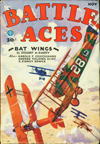 DURING the latter part of September, 1918, the start of the big Argonne push was getting under way. At the time, we of the 147th aero squadron, 1st pursuit group, A.E.F., were stationed at Rembercourt almost due west of St. Mihiel and south of Grand Pre. The first pursuit group was called upon to carry out a great variety of special assignments in collaboration with the movement of ground troops. Some of these assignments were balloon strafing, troop strafing, contact patrol and escort work of various kinds.
DURING the latter part of September, 1918, the start of the big Argonne push was getting under way. At the time, we of the 147th aero squadron, 1st pursuit group, A.E.F., were stationed at Rembercourt almost due west of St. Mihiel and south of Grand Pre. The first pursuit group was called upon to carry out a great variety of special assignments in collaboration with the movement of ground troops. Some of these assignments were balloon strafing, troop strafing, contact patrol and escort work of various kinds.
Our troops were attempting to straighten out the line and in doing so encountered very strenuous resistance from both the German artillery and infantry.
On the morning of September 28th, the operation officer called me into his office and advised that our troops were experiencing difficulty in straightening out the line near Cierges, France. He advised that I was to take a patrol out and strafe the German front-line troops. At the same time he ordered me to be on the lookout for enemy two-seaters which might be regulating artillery fire in that specific sector.
After receiving the orders I walked out onto the line to ascertain how many ships I had available for patrol duty. I found that, including my own, we had only three serviceable ships—those of Lt. O.B. Myers and Lt. L.C. Simon, Jr. I immediately rounded up “Obie†Myers and “Red†Simon and informed them of the somewhat difficult mission.
We accordingly took off and proceeded immediately to the Front, Obie flying on my immediate left and Red on my immediate right. We easily located the particular portion of the line which was causing the difficulty by the great concentration of artillery fire, machine-gun activities, etc. After carefully sizing up the situation, we realized the reason for our inability to displace the German position. The front line of the enemy was immediately back of the crest of a small ridge, making it easy for the Boches to keep up a scathing fire without undue exposure to themselves.
Hastily glancing at the sky to see that there were no enemy Fokkers lurking around, I swung my formation into an attacking position and raked the entire crest of the ridge with machine-gun fire. Immediately the Germans let loose with their anti-aircraft defense. Upon pulling away after the first attack I noticed that our anti-aircraft guns were sending shells into our vicinity, which caused me to more carefully survey the skies. Immediately I discovered a patrol of nine enemy Fokkers rapidly approaching. I decided to make one more hasty attack at the troops on the ground and then attempt to better our own defensive position from the attack of the nine Fokkers.
After completing the ground attack I rapidly climbed the patrol and at the same time signaled both Obie and Red to close in. We had gained about 500 meters when I discovered the reason for the presence of the nine Fokkers. A German Hanoverian two-seater was regulating artillery on our ground-line troops which were attempting to take the ridge that we had just strafed. I swung my patrol over toward the Hanoverian and the Fokkers made immediate plans to attack us.
As we crossed over the position of the Hanoverian, Obie dived out of formation and coming up under the tail of the Hanoverian raked it with devastating fire from his machine gun. The Hanoverian fell off almost immediately and burst into flames, crashing right near the town of Cierges. Meanwhile the Fokkers had jumped us and were making things very interesting for Red and me. We were seriously outnumbered and were making a running fight of it all the time working our way toward home, when Obie climbed back into position and flew straight into the middle of the fight, shooting at everything that came in his way. This diversion put the Fokkers on the defensive and we immediately drove them back toward their line. Out of the group we shot down one Fokker and badly disorganized the rest.
Upon returning to the airdrome we discovered that all of our ships had been pretty badly shot up in the engagement, but no serious damage done. The first thing that Red said on landing was “Oh boy, did you see that Boche burn!†Obie replied that he had not seen the ship go down in flames but he was sure that he had gotten it from the way it fell out of control. Both Red and myself saw the two-seater burst into flames. The victory was later confirmed by our own ground troops. While Obie always claimed that it was a bit of luck on his part to have gotten the two-seater so quickly, I always claimed that it was very pretty flying.
The ships used at this time by our squadron were Spad’s, type 13, and the ship flown by Obie bore the squadron number 28. These ships were equipped with 220 H.P. Hispano motor with geared-down propeller. This was one of the earliest types of service machine to use a motor with a gear reduction. The Spad was a small biplane of about 30 feet wing-spread, the wings having neither stagger nor dihedral. The armament consisted of two Vickers machine guns mounted and synchronized to shoot through the propeller. In order to aim the guns the ship had to be aimed, in other words flown into firing position. This type of Spad was capable of a top speed of 135 miles per hour and up to that time, with the exception of the Fokker D-7, was about the best ship on the front.

“O.B. Myers: Flying Hero” by Frederick M. Blakeslee (November 1931)
You have just read in the foregoing story how O.B. Myers won his Distinguished Service Cross. All of the authors in BATTLE ACES are real flyers and fighting aces, and believing that you would like to know a bit about them personally as well as to read the stories they write, we got Ken Porter to tell you the interesting story about Obie’s first flight across the lines. Usually, when a green peelot took his first trip over, he missed his landmarks, got jumpy under anti-aircraft barrage, and couldn’t even see enemy planes if he was attacked. But did Obie beat it at the first sign of trouble? Wow—we’ll tell the cockeyed flying world he didn’t! Ken Porter, who was assigned to break him in, tells this unusual story here for the first time.

Obie’s First Flight
By Kenneth L. Porter • Battle Aces, November 1931
EARLY in September, just after the completion of the St. Mihiel push, we were located at Rembercourt which was almost due south of Souilly and approximately sixty or seventy kilometers from Bar-le-Duc. For quarters we had tents which were pitched in a small clump of trees on the side of a hill just across the road from our airdrome. Whenever it rained the water succeeded in flooding our tent and making us very uncomfortable.
The St. Mihiel Drive had thinned our ranks considerably and we were expecting several replacements at any time. One evening, just after mess, we returned to our tent and discovered that five or six new pilots were temporarily housed in C Flight tent. It was customary, upon the arrival of new pilots, for the boys to look them over and decide in their own minds just who they wanted attached to their particular flights.
Among the new arrivals was one Lt. O.B. Myers and Lt. Hayward Cutting. “Whitie,” who was flight commander at that time, drew me aside and asked me what I thought about the new arrivals. I told him that if possible we should get Myers and Cutting attached to our flight. Whitie accordingly called on the C.O. that evening and requested that the two boys in question be attached immediately.
It is a rather peculiar situation when new pilots arrive on the Front as they are more or less under a tension and as a rule don’t act naturally. They seem to think that they have to throw some kind of a bluff to impress the boys who are already there. One of the outstanding characteristics of Obie was that he seemed perfectly natural and entirely unperturbed as to what the future held. Of course, all new pilots, upon arrival, immediately want to have a ship assigned to them and participate in regular patrols.
A few days after his arrival, Obie sought me out one morning and asked me when he could expect to participate in regular patrols. I pointed out to him that we were rather short on planes at the time, but I would see what I could do about the situation and try to get him a joy hop anyway. I had a talk with “Whitie” and we decided that we would let Obie use Lt. Bronson’s ship for a little joy ride, as Lt. Bronson was away on leave. I took Obie over to the airdrome and told him to take Bronson’s ship up for half or three-quarters of an hour to familiarize himself with a new type of plane and that after he felt that he was satisfied with the handling of the ship, he could go over to a nearby lake and practice shooting at the flying target which we had anchored there.
Obie went through these preliminary tests very satisfactorily and upon his return to the ground he collared me and pleaded with me to take him out for a look at the lines. I told him that if the weather improved a little, we would take an observation tour on the next morning.
When we awoke the following day, the weather looked none too good. There was considerable haze on the ground and the clouds were not over 1,200 meters high. Not only that, but it had been raining slightly during the night. I requested information of headquarters as to weather conditions on the Front and found they were about the same as those prevailing at our own airdrome. Accordingly, about ten o’clock, we decided to make a tour of the Front with a view to familiarizing Obie with the landmarks and conditions as they existed up there. Taking him into the operations tent where there was a map of our entire sector, I carefully pointed out the exact route we were to follow.
Now, among other things that are lacking when a pilot arrives on the Front is his ability to see things from the air. Some pilots acquire it very quickly, while others take time, but as a rule when they do acquire it, it happens all of a sudden. I told Obie that we would fly due east to St. Mihiel and from there to the north over the ridge of hills to Verdun. From Verdun we would swing west along our front line over Montfaucon to the river which goes through the middle of the Argonne forest.
It is a rather ticklish situation to have a new pilot with you on his first trip over the lines, so I was very explicit in requesting Obie not to pay too much attention to landmarks, but to stick close to me, and that above all, if we got into any trouble, to stay close on my tail and that I would lead him home. I further advised him that if we met any Germans he was to stay out of the fight and watch me, as he probably could learn more from watching my tactics than he could from getting himself shot up.
As it was immediately after the St. Mihiel Drive and just prior to the final Argonne push, there were practically no aerial activities and I felt fairly safe. In fact I didn’t expect to see anything more than a good anti-aircraft barrage. Finally feeling that Obie fully understood the instructions, we took off and made our way leisurely to the Front by way of St. Mihiel. We were flying pretty close up under the clouds at about a thousand meters altitude when we reached St. Mihiel. From time to time, I glanced back to see just where Obie was. Each time I looked back, it seemed that he was closer to me; in fact he was riding so close to my tail that it was a little bit uncomfortable.
Consequently when we arrived at St. Mihiel, the Boches let loose with their anti-aircraft guns and we received a very nice dose of it. I expected, after the barrage, to find Obie at a considerable distance away from me, but upon looking back I discovered that he was in his usual position—right on my tail. This was somewhat unusual, as most new pilots, upon experiencing their first heavy barrage, go through all sorts of aerial acrobatics and stunts and find themselves a considerable distance away from where they should be. I began to feel a little less worried about Obie and proceeded more confidently to Verdun.
We had almost reached Montfaucon when I noticed that the Germans were putting up one of their balloons just to the east. Everything had been going so smoothly that I decided to show Obie how a balloon was shot down. As we approached the Boches apparently divined my purpose, because they immediately started to pull the drachen down.
Prior to leaving the ground I had told Obie that in the event of attacking any balloons or going close to the ground he was to remain up above and watch. I therefore signaled him that I was going to dive and without looking around, did so. The balloon was about halfway down when I opened fire, raking it from end to end with machine-gun fire. Incidentally, I didn’t have any incendiary ammunition in my guns, as we were not supposed to carry it unless specifically ordered to strafe balloons. The air being damp and the envelope of the balloon covered with moisture, there was no apparent effect of burning as a result of my shots. I pulled off and climbed back up a short distance to attack the balloon once more, when to my astonishment I saw Obie giving the sausage a dose of the same medicine.
He pulled up from his attack and dove in again. By this time the balloon was pretty close to the ground. As I opened fire the second time, they let loose at me from the ground with everything they had—machine guns, flaming onions, rockets and what have you. Following my example, Obie also came in for a second dose, and was treated to the same display of fireworks. While we didn’t burn the balloon, we put enough holes in it to keep it on the ground for a couple of days while it was being patched. As I pulled up from my second attack and circled over, Obie climbed up and got into his usual position on my tail. By this time, I was beginning to feel that he was almost a passenger in my own plane and had no more fears that I would lose him, or could even shake him loose if I wanted to.
We had hardly reached our lines before I noticed a barrage of our own antiaircraft. This barrage was in front of me—or in other words, between me and home and would indicate that there were German airplanes in that vicinity. I felt that I would probably run into some kind of a fight before we had proceeded much further. Almost immediately I saw what the cause of the excitement was—a two-seater Halberstadt, which was regulating artillery fire on our troops, The clouds were so low that I didn’t like the looks of the situation because I felt that the two-seater would probably have some chasse protection. However, I couldn’t seem to find them and decided that the two-seater must be done away with. We already had him blocked off from home and so I now endeavored to force him still further back into our lines where the advantage would be much more in my favor. However, the Jerry seemed to think otherwise and headed straight for home. Consequently, I again signaled to Obie to stay up above, and dove in to attack.
Then I put the ship into a steep dive and came up under the tail of the two-seater, slightly from one side. I got in about ten rounds before I fell off, and was swinging around to make another attack when, to my astonishment, again Obie was attacking the two-seater from above. I immediately turned sharply and gave him another burst from below, with the result that the two-seater went down out of control. Meantime, Obie had climbed back up and I was probably 400 meters below him, when two German Fokkers dropped down from the clouds. For a few minutes I was so busily engaged that I had no more than a passing moment to think of Obie. I was hoping that there were no more than two of them, and that he had not been surprised by the attack. I finally got on the tail of one of the Fokkers and was giving him the works when I heard guns and was aware of bullets going by my head and realized that another Boche was immediately on my tail.
It was necessary for me to pull over in order to protect myself. As I did so, I heard the sound of some more guns, and both the Jerry and Obie dove past me hell-bent. We now had the two Dutchmen below us and I swung back to renew hostilities, but by this time I discovered that we had drifted considerably into German territory, and as we had been out about an hour and a half, we only had about enough gas to get us home. Consequently, I dove in front of Obie and signaled him to follow me. Then we turned back home. We arrived without any uneventful happenings other than my mixed feelings and amazement at the show this new pilot had put up.
After each patrol it is customary for a pilot to make out a combat report. I was interested to see what kind of one Obie was going to make of his first flight. While we were in the operations tent preparing to make out these reports, the flight sergeant came in and reported that Lieutenant Myers had eight bullet holes in his plane and that the tail of my ship had so many in it he couldn’t count them. I told Myers to go ahead and make out his report. He advised me that I had better make mine out first, as, while he knew we had shot at a balloon, engaged a two-seater and two Fokkers in combat, he had no idea where the action occurred. This, of course, was no more than was to be expected from a man who is unfamiliar with the territory over which he has flown. I therefore wrote out my report and Obie practically wrote “ditto.”
Later we received confirmation of the victory over the two-Seater, and the fact was also mentioned that we had succeeded in forcing the Germans to pull down one of their balloons. While we didn’t claim a victory over either of the Fokkers, one of them was reported to have crashed just inside the German lines. Obie, in his first show, had proved himself to be decidedly an exception to the average both as to attitude and results.

The 147th Aero Squadron They are, standing, from left to right, 1Lt Oscar B Meyers, 2Lt Arthur H Jones, 2Lt Edward H Clouser (adjutant), 2Lt Ralph A O’Neill (five victories), ILt James A Healy (five victories), 2Lt Charles P Porter, Maj Harold E Hartney, commander 1st Pursuit Group (seven victories), Capt James A Meissner, commander 147th Aero Squadron (eight victories), 1Lt Heywood E Cutting, 1Lt James P Herron, 2Lt Francis M Simonds (five victories), 1Lt George H Brew, 2Lt G Gale Willard, 2Lt Cleveland W McDermott and 1Lt Collier C Olive. Squatting, from left to right, ILt Walter P Muther, 2Lt Frank C Ennis, 2Lt Louis C Simon Jr, 1Lt G A S Robertson, 2Lt Stuart T Purcell, 2Lt Thomas J Abernethy, 1Lt Horace A Anderson (supply officer), 1Lt Josiah P Rowe Jr, 2Lt James C McEvoy and 2Lt John W Havey (armament officer)

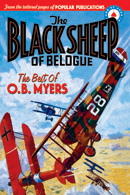 Both of these stories are featured in our collection of stories by O.B. Myers—The Black Sheep of Belogue: The Best of O.B. Myers which collects his Black Sheep of Belogue stories featuring Yank Ace Dynamite Pike and his trusted mechanic Splicer Teale and The Mongol Ace stories which pits American pilot Clipper Stark against the seemingly invincible “Mongol Ace”—Janghiz Kaidu, a descendant of Genghis Kahn who has joined the German army. Some great stories!
Both of these stories are featured in our collection of stories by O.B. Myers—The Black Sheep of Belogue: The Best of O.B. Myers which collects his Black Sheep of Belogue stories featuring Yank Ace Dynamite Pike and his trusted mechanic Splicer Teale and The Mongol Ace stories which pits American pilot Clipper Stark against the seemingly invincible “Mongol Ace”—Janghiz Kaidu, a descendant of Genghis Kahn who has joined the German army. Some great stories!
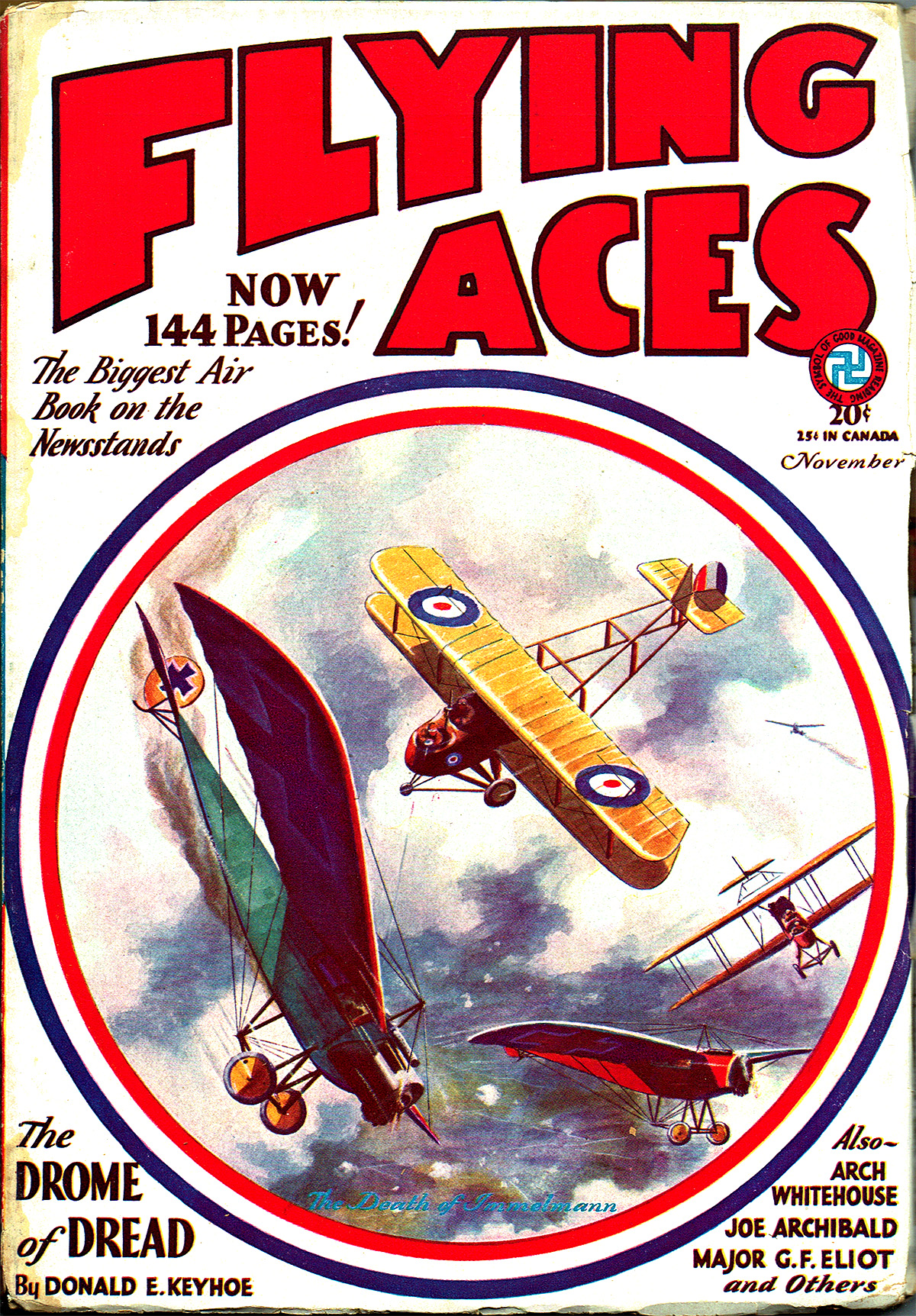 That sound can only mean one thing—that Bachelor of Artifice, Knight of Calamity and an alumnus of Doctor Merlin’s Camelot College for Conjurors is back to vex not only the Germans, but the Americans—the Ninth Pursuit Squadron in particular—as well. Yes it’s the marvel from Boonetown, Iowa himself—Lieutenant Phineas Pinkham!
That sound can only mean one thing—that Bachelor of Artifice, Knight of Calamity and an alumnus of Doctor Merlin’s Camelot College for Conjurors is back to vex not only the Germans, but the Americans—the Ninth Pursuit Squadron in particular—as well. Yes it’s the marvel from Boonetown, Iowa himself—Lieutenant Phineas Pinkham! 




 a story from Curtis Mitchell. Mitchell was born in Mexico, MO in 1902. He started his career as a newspaper man working for both the hometown papers—The Daily Ledger and The Intelligencer—even becoming the city editor for the former before heading east to New York in 1922 to become the publicity director for the Charity Organization Society of New York City. From there he worked his way back in to publishing becoming the youngest editor and vice president of a publishing house, Dell. He edited a variety of magazines, most dealing with entertainment like Film Fun and Film Humor and latter Modern Screen Magazine and Radio Stars. From 1928 to 1934, Mitchell was a frequent contributor to the aviation pulps like Wings, Sky Riders, Flying Aces, Air Trails, Air Stories, Sky Birds and War Birds.
a story from Curtis Mitchell. Mitchell was born in Mexico, MO in 1902. He started his career as a newspaper man working for both the hometown papers—The Daily Ledger and The Intelligencer—even becoming the city editor for the former before heading east to New York in 1922 to become the publicity director for the Charity Organization Society of New York City. From there he worked his way back in to publishing becoming the youngest editor and vice president of a publishing house, Dell. He edited a variety of magazines, most dealing with entertainment like Film Fun and Film Humor and latter Modern Screen Magazine and Radio Stars. From 1928 to 1934, Mitchell was a frequent contributor to the aviation pulps like Wings, Sky Riders, Flying Aces, Air Trails, Air Stories, Sky Birds and War Birds.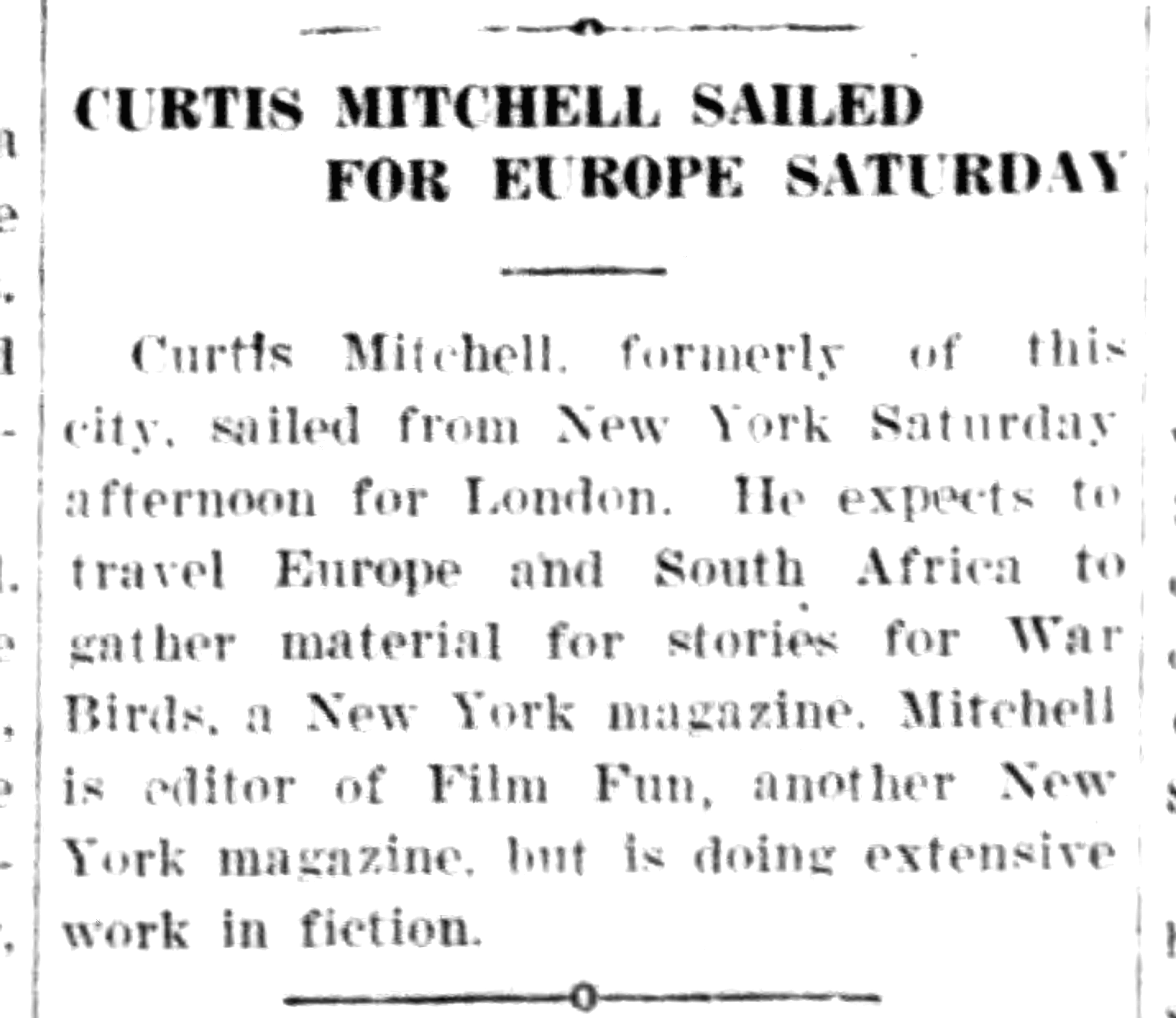
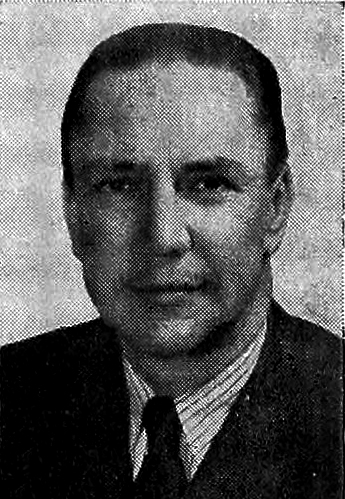 Colonel Curtis Mitchell, recently pictorial chief for the War Department Bureau of Public Relations and now on terminal leave after four and one-half years of active service, assumed the duties of director of advertising and publicity for Paramount Pictures on November 1, it was announced Wednesday by Charles M. Reagan, Paramount vice-president in charge of distribution. He succeeds to the post vacated by R.H. Gillham, who resigned.
Colonel Curtis Mitchell, recently pictorial chief for the War Department Bureau of Public Relations and now on terminal leave after four and one-half years of active service, assumed the duties of director of advertising and publicity for Paramount Pictures on November 1, it was announced Wednesday by Charles M. Reagan, Paramount vice-president in charge of distribution. He succeeds to the post vacated by R.H. Gillham, who resigned.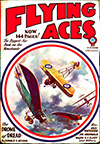

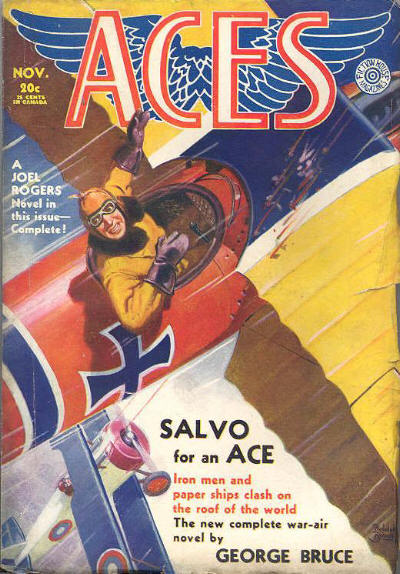 by Joel Townsley Rogers. Born in 1896 and studied at Harvard, Rogers saw The Great War as an adventure and joined the Navy Air Corp and became one of it’s first few hundred pilots. Unfortunately, the war ended before he saw action and ended up as a flight instructor at Pensacola instead. After the war, he turned his experiences into stories for the pulps. In addition to air stories, Rogers also wrote numerous mystery and science-fiction stories as well.
by Joel Townsley Rogers. Born in 1896 and studied at Harvard, Rogers saw The Great War as an adventure and joined the Navy Air Corp and became one of it’s first few hundred pilots. Unfortunately, the war ended before he saw action and ended up as a flight instructor at Pensacola instead. After the war, he turned his experiences into stories for the pulps. In addition to air stories, Rogers also wrote numerous mystery and science-fiction stories as well.  by H.P.S. Greene. Henry Paul Stevens Greene wrote aviation tales from the late 20’s to the early 40’s for magazines like Wings, Air Stories, Sky Fighters and, the magazine this story appeared in—Aces.
by H.P.S. Greene. Henry Paul Stevens Greene wrote aviation tales from the late 20’s to the early 40’s for magazines like Wings, Air Stories, Sky Fighters and, the magazine this story appeared in—Aces. a story by Syl MacDowell! MacDowell is probably best known for his westerns. This time, MacDowell gives us brief tale of the mysterious Black Bat—is he man or beast? From the November 1931 issue of Aces, it’s “The Black Bat.”
a story by Syl MacDowell! MacDowell is probably best known for his westerns. This time, MacDowell gives us brief tale of the mysterious Black Bat—is he man or beast? From the November 1931 issue of Aces, it’s “The Black Bat.”







